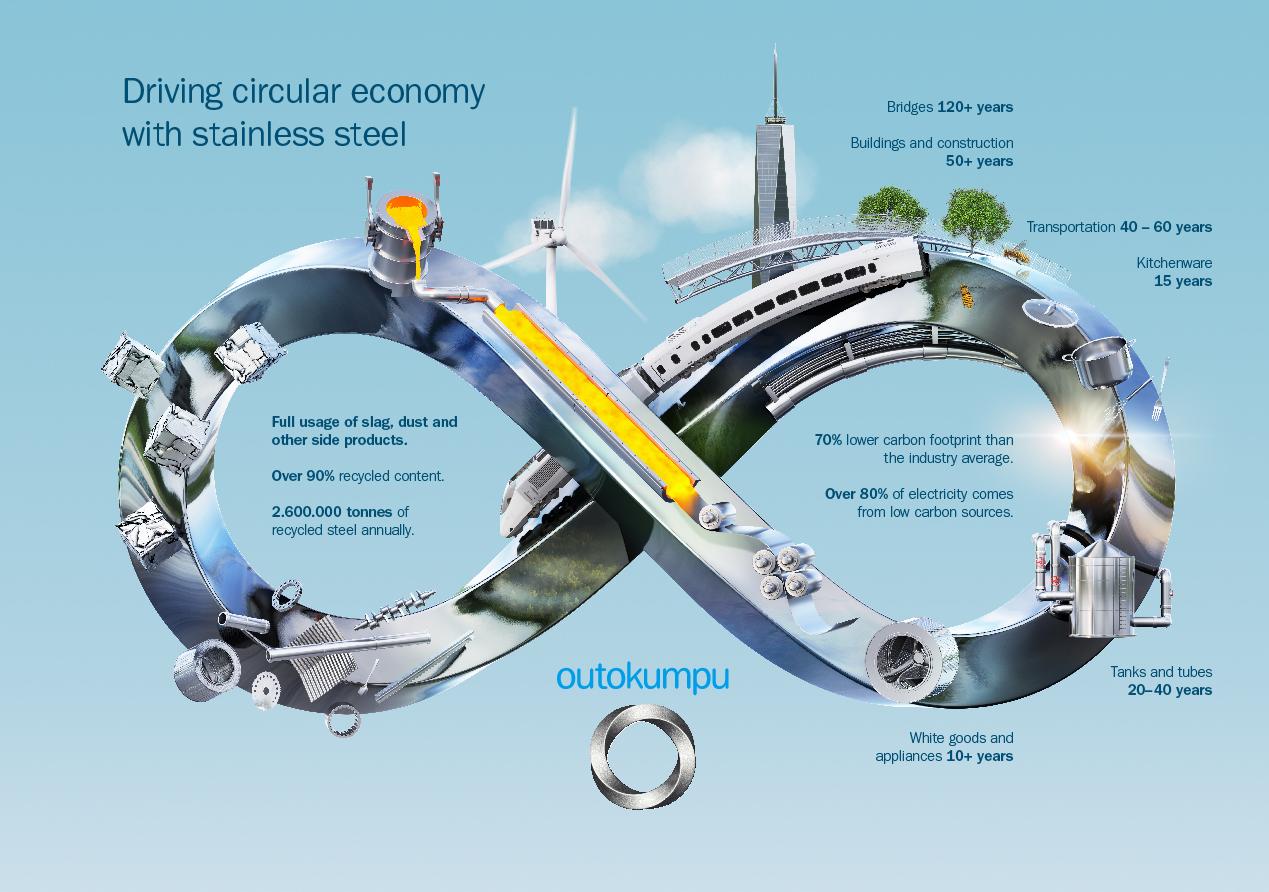
Recycling and durability
Our most important raw materials are recycled stainless and carbon steels. Recycling a product saves resources by reducing the need to extract new minerals and ores from the ground. The average recycled material content for all stainless produced by Outokumpu is over 90%, the highest on the market. In 2022, we reached an all-time high recycled material content rate of 94%, incl. steel scrap and waste streams from our production. In comparison, a recent study by the Yale University showed that the global average of recycled content is only 44%.
However, durability is also important. Manufacturing something only once, instead of twice or even three times during a certain time period, due to breakdowns and repair, is of course less resource consuming. Stainless steel helps to prolong the lifetimes of applications, for example bridges susceptible to corrosion, or components like exhaust pipe systems in cars.
A study by Boston Consulting Group on the CO2 emissions related to the six relevant uses of steel revealed that CO2 savings in the use phase are six times the CO2 needed to produce the steel.
Low life-cycle costs for stainless steel
The durability of stainless steel also has a cost-effective impact from a life-cycle perspective. Stainless steel requires only minimal maintenance, which is both economical and good for the environment and society. The combination of corrosion resistance and durability increases product lifetime. In certain cases, these cost savings can be in the range of 30% to 40% compared to alternative materials, and they arise from reduced repair and maintenance costs.
Overall life-cycle impact of our products
The strengths of Outokumpu’s stainless steel are especially visible from a life cycle perspective. By paying more attention to life cycle oriented environmental management and conducting several life cycle inventory studies we have been able to point out and act on the most efficient ways to reduce the overall life cycle impact of our products.
The use of Outokumpu's steel in modern society minimizes emissions by creating efficiency in, for example, transport, construction and energy production. Thus, Outokumpu’s stainless steel supports prosperity and health. Other means of, and our strengths in, reducing our environmental impact are:
- Efficiency in energy use
- Choice of electricity sources
- Material efficiency in production
In energy efficiency, Outokumpu is taking a long-term approach: the target is a continuous improvement of a 0.5% reduction yearly.
In choosing electricity sources, Outokumpu participates in low-carbon electricity production, such as new power plant projects, and enters into agreements with parties in the power market, contributing to the future construction of adequate power production capacity.
Improving resource efficiency is the most effective measure Outokumpu has to directly reduce the environmental impacts of steel production. Outokumpu aims to have a steel production system where all the materials resulting from production are fully utilized and manufacturing processes have been developed to facilitate this. For instance, Outokumpu is able to utilize its own ferrochrome which further strengthen our footprint: our ferrochrome process is efficient and since we operate the only chrome mine in Europe close by the Tornio mill, the impact of the transport is minimized.
End of the life cycle
"End of Life" describes the phase in a product or solution's life cycle where its active usage comes to an end. What happens during the "end of life" is significant in terms of environmental efficiency. Stainless steel can be recycled infinitely - and it suffers no quality degradation during reprocessing.
Recycled stainless steel is valuable material and the recycled steel market is a viable large scale business. Environmental and sustainability benefits of recycling, such as conservation of non renewable resources, saving energy, avoiding emissions and reducing waste, affect an entire society's sustainability.
The end of life recycling rate for stainless steel is over 80% on average. Since stainless steel is used in a wide range of sectors, from architecture, building and construction and also in industrial machinery where the average rate is over 90% recycled, to sectors where the recycling rate is only some 60%. By these sectoral rates, also known as recovery ratios, stainless steel industry follows the overall recycling efficiency. One way of improving a product's sustainability is to make an effort during the product design phase in order to aid efficient recycling at the end of active usage phase.
Stainless steel has valuable metal content - chromium and nickel. Markets for recycled stainless steel are functioning without any stimulus and the stainless steel industry is utilizing all feasibly available recycled stainless steel. All Outokumpu production sites use recycled material as main raw material. However, there is not enough recycled steel containing nickel and chromium on the market to satisfy the demand for production of new stainless steel. This means that stainless steel made today is recycled multiple times and the virgin ore such as chromium and other alloys added during production will remain in stainless steel stock actively used by society. Disposal of stainless steel waste to landfills is not harmful to the environment, but is a waste of resources.
